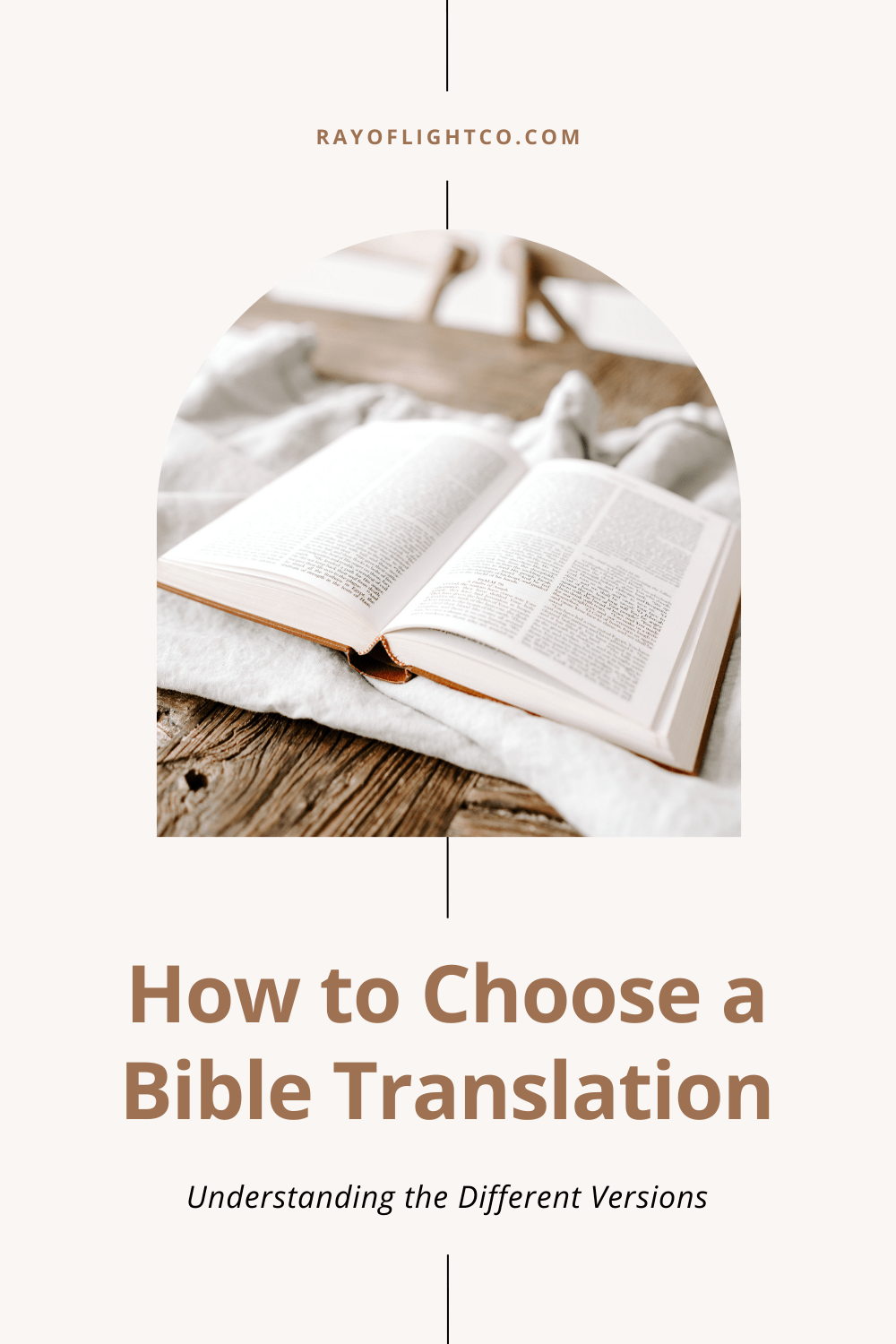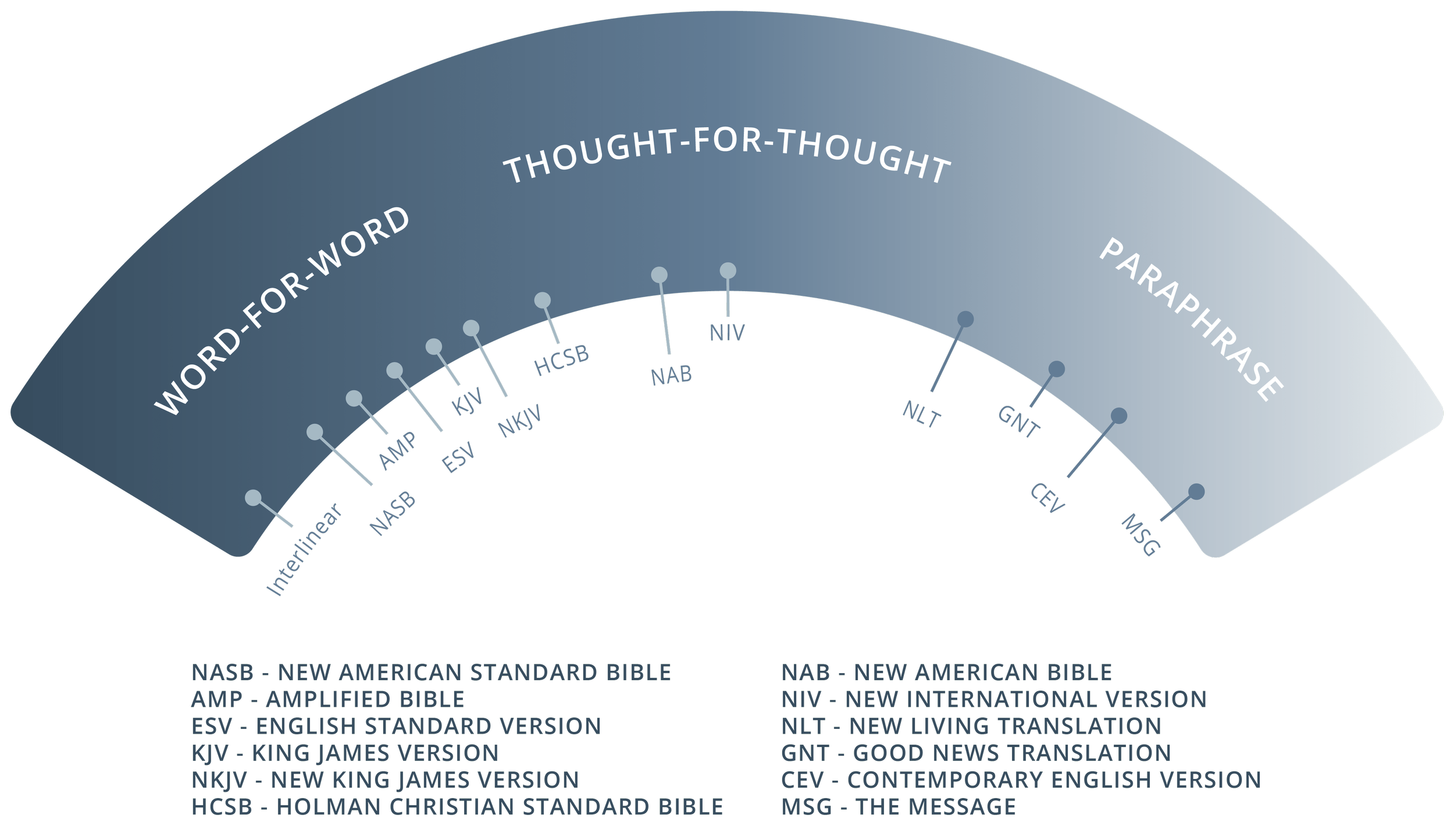How to Choose a Bible Translation
*This post contains affiliate links. When you buy through affiliate links on this site, I earn a small commission at no extra cost to you. For more information, see my privacy policy.
There are many different translations (or versions) of the Bible. While it may seem overwhelming when trying to choose which to read, it's actually to our benefit. In this post, we are going to look at how the Bible is translated and how to use different translations to help us study God’s Word.
The 3 Categories of Translations
Bible translations can be separated into three categories: Word-for-Word, Thought-for-Thought, and Paraphrase. Each version and category has its own style and function. While the underlying meaning of the Scriptures is essentially the same, the way in which they are relayed to the reader varies for the purpose of understanding. Let's unpack these categories to help us understand how and when to use them.
WORD-FOR-WORD
Word-for-word versions (sometimes referred to as "literal translations") are basically what they sound like. When translating the Scriptures from the original languages, these versions attempt to keep the exact words and phrases. They give us one English word or phrase for each word or phrase in the original language and even try to keep them in order.
While word-for-word translations stay true to the original text, they can sometimes be tough to read. These versions are best used for in-depth Bible studies.
Examples: *Interlinear, New American Standard Bible (NASB), *Amplified Bible (AMP), *English Standard Version (ESV), King James Version (KJV), and New King James Version (NKJV).
*Denotes my preferred translations.
Philippians 1:21
Amplified Bible
For to me, to live is Christ [He is my source of joy, my reason to live] and to die is gain [for I will be with Him in eternity].
English Standard Bible
For to me to live is Christ, and to die is gain.
King James Version
For to me to live is Christ, and to die is gain.

|
THOUGHT-FOR-THOUGHT
Thought-for-thought versions look at an entire sentence and translate/rearrange the wording to make the most sense in modern English. Rather than focusing on translating each individual word, these versions stay true to the meaning while allowing some leniency in the exact verbiage to convey it. They maintain historical and cultural facts from the time it was written but update the wording for ease of reading.
Thought-for-thought translations are great for everyday reading and devotions. They may be useful in Bible study when accompanied by a Word-for-word version or a Concordance.
Examples: Holman Christian Standard Bible (HCSB), *New International Version (NIV), New American Bible (NAB), and *New Living Translation (NLT).
*Denotes my preferred translations.
Philippians 1:21
Holman Christian Standard Bible
For me, living is Christ and dying is gain.
New International Version
For to me, to live is Christ and to die is gain.
New Living Translation
For to me, living means living for Christ, and dying is even better.
PARAPHRASE
Paraphrase versions (or “Free Translations”) maintain the basic facts of Scripture—including people, places, events, and theological truths, but seek to be culturally relevant to the modern day. They look at an entire section of Scripture, whether that be a paragraph, speech, or an entire chapter, and attempt to convey its main point through modern phrases and metaphors. These translations rearrange the original wording to create a smooth flow and easy understanding for the reader.
While Paraphrase translations are readable, they lack precision. These versions should only be used when accompanied by a Word-for-Word or Thought-for-Thought translation. They may be good for devotionals or hand-lettering but are not recommended to study the Bible.
Examples: Good News Translation (GNT), Contemporary English Version (CEV), and The Message (MSG).
Philippians 1:21
Good News Translation
For what is life? To me, it is Christ. Death, then, will bring more.
Contemporary English Version
If I live, it will be for Christ, and if I die, I will gain even more.
The Message
Alive, I’m Christ’s messenger; dead, I’m his prize. Life versus even more life! I can’t lose.
Choosing A Translation
Choosing a Bible translation doesn’t have to be overwhelming and it certainly doesn’t have to be set in stone. While I do recommend your default translation fall in the Word-for-Word or Thought-by-Thought categories to stay as close as possible to the original meaning, one Bible study “best practice” is to compare versions in all types of translation to deepen your understanding. The version you default to is really just the one you read first and most often.
What’s Worked for Me
The first Bible I was gifted was a New Internation Version (NIV). The NIV falls right in the middle of the translation spectrum, so it’s easy to read, but not so far from the original language that I feel like I am missing the meaning.
I currently have the NIV Journaling Bible that I’ve been working my way through for the past couple of years with the goal to fill it up with notes to gift to my son one day. Though my physical copy is an NIV, the translations I like to compare it with include the:
Interlinear
Amplified Bible (AMP)
English Standard Version (ESV)
New Living Translation (NLT)
And sometimes The Message (MSG)

I cannot recommend a Journaling Bible enough! They contain 1-inch margins perfect for note-taking & hand-lettering. Click the image for the NIV Journaling Bible or snag the ESV Journaling Bible here.
I will say, the NIV served me well as my main translation of choice in the earlier years of my faith, but now that I’ve become more confident in studying the Bible, my plan is to transition to a Word-for-Word translation after I’m done filling up my current one.
My absolute favorite has to be the Amplified (AMP) version because (as its name suggests) it amplifies the meaning of Scripture to make clear what was meant when it was written, but I will also say the English Standard Version (ESV) is very popular for both staying close to the original meaning while also being readable.
Whatever you choose, my hope and prayer is this post helped provide some guidance so you can draw closer to God through the Truth of His infallible Word.
What about you? Do you use another translation not listed in this post?











